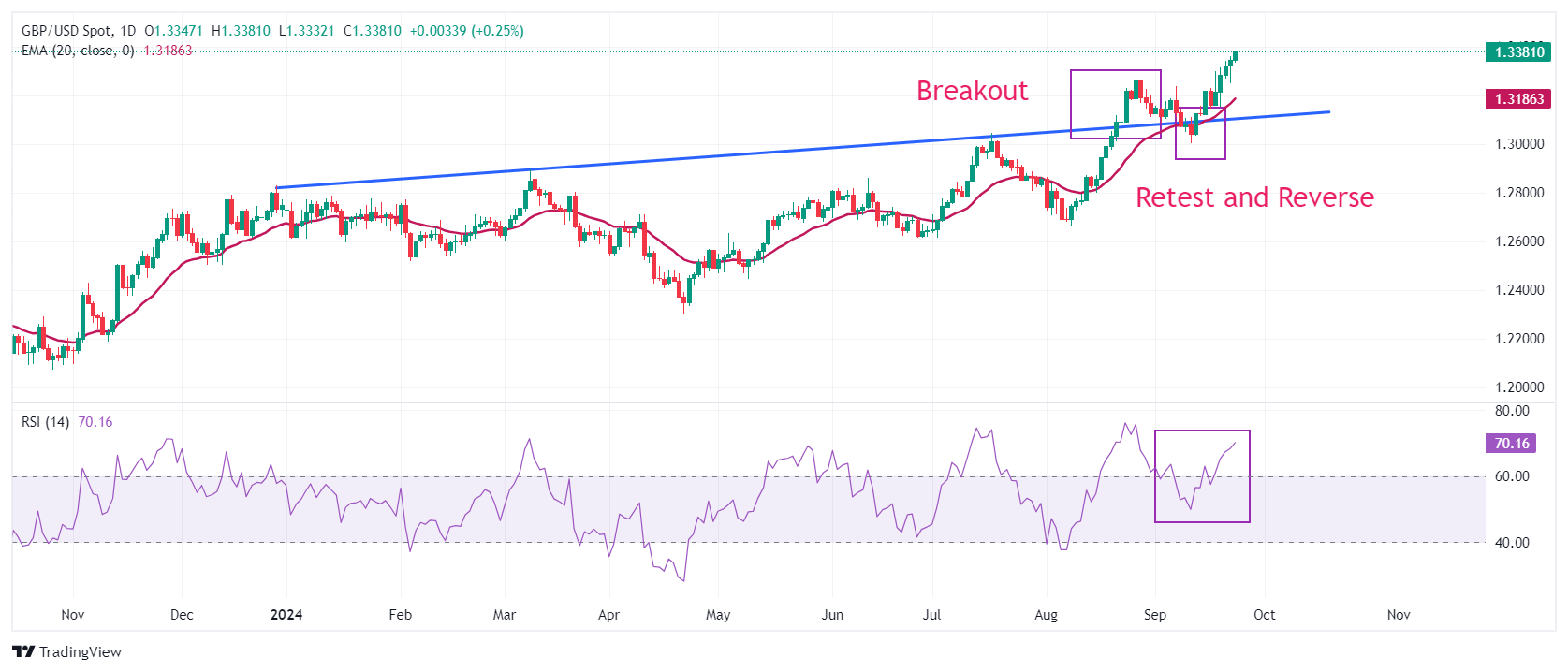- The Pound Sterling moves higher to near 1.3400 against the US Dollar on expectations of BoE’s shallow policy-easing cycle.
- UK’s overall business activity grew at a slower pace in September, according to a flash estimate.
- Traders raise Fed 50 bps rate cut bets for November.
The Pound Sterling (GBP) gains further against its major peers on Tuesday. The British currency strengthens as investors expect that the Bank of England’s (BoE) policy-easing cycle would be shallower than other central banks from Group of Seven (G-7) nations.
Financial markets expect that the BoE will cut interest rates one more time this year, which will come in any of its two monetary policy meetings remaining this year. High inflation in the United Kingdom’s (UK) service sector seems to be the major reason behind market expectations of BoE’s less-dovish interest rate outlook.
Annual service inflation, which is closely tracked by Bank of England officials, has risen sharply to 5.6% in August from 5.2% in July.
Meanwhile, the comments from BoE Governor Andrew Bailey in his speech during the European trading session on Tuesday indicated that the policy-easing cycle would be gradual.
On the economic front, Flash UK S&P Global/CIPS Purchasing Managers Index (PMI) data for September came in slightly lower but remained above the 50.0 threshold that separates expansion from contraction. The report showed that the overall private business activity fell to 52.9 from 53.8 in August due to a faster-than-expected slowdown in activities in both the manufacturing and service sectors.
Daily digest market movers: Pound Sterling extends its upside against US Dollar
- The Pound Sterling extends its winning streak for the fifth trading day against the US Dollar (USD) on Tuesday. The GBP/USD pair climbs above 1.3350 as the US Dollar drops amid growing speculation that the Federal Reserve (Fed) could opt for a 50 basis points (bps) interest rate cut for the second time in a row when they meet in November. The US Dollar Index (DXY), which tracks the Greenback’s value against six major currencies, remains under pressure below 101.00.
- The Fed started reducing interest rates from the monetary policy meeting on Wednesday, in which the central bank cut its key borrowing rates by 50 basis points (bps) to a target range of 4.75%-5.00%. The Fed started the policy-easing cycle with a larger-than-usual rate cut as officials focused majorly on preventing job losses, with increased confidence that price pressures will return to the bank’s target of 2%.
- According to the CME FedWatch tool, the likelihood that the Fed will cut interest rates by 50 bps to 4.25%-4.50% in November is close to 51% from 29% a week ago.
- This week, investors will keenly focus on the US Personal Consumption Expenditures Price Index (PCE) data for August, which will be published on Friday. Economists expect the core PCE price index to have grown 2.7% from 2.6% in July.
US Dollar PRICE Today
The table below shows the percentage change of US Dollar (USD) against listed major currencies today. US Dollar was the strongest against the Japanese Yen.
| USD | EUR | GBP | JPY | CAD | AUD | NZD | CHF | |
|---|---|---|---|---|---|---|---|---|
| USD | -0.44% | -0.37% | -0.06% | -0.43% | -0.52% | -0.86% | -0.26% | |
| EUR | 0.44% | 0.07% | 0.37% | -0.03% | -0.08% | -0.44% | 0.18% | |
| GBP | 0.37% | -0.07% | 0.31% | -0.06% | -0.13% | -0.51% | 0.12% | |
| JPY | 0.06% | -0.37% | -0.31% | -0.34% | -0.46% | -0.82% | -0.19% | |
| CAD | 0.43% | 0.03% | 0.06% | 0.34% | -0.09% | -0.43% | 0.18% | |
| AUD | 0.52% | 0.08% | 0.13% | 0.46% | 0.09% | -0.35% | 0.26% | |
| NZD | 0.86% | 0.44% | 0.51% | 0.82% | 0.43% | 0.35% | 0.63% | |
| CHF | 0.26% | -0.18% | -0.12% | 0.19% | -0.18% | -0.26% | -0.63% |
The heat map shows percentage changes of major currencies against each other. The base currency is picked from the left column, while the quote currency is picked from the top row. For example, if you pick the US Dollar from the left column and move along the horizontal line to the Japanese Yen, the percentage change displayed in the box will represent USD (base)/JPY (quote).
Technical Analysis: Pound Sterling climbs to near 1.3400
The Pound Sterling rises further to 1.3400 against the US Dollar in North American trading hours. The near-term outlook of the GBP/USD pair remains firm as all short-to-long-term Exponential Moving Averages (EMAs) are sloping higher.
Earlier in September, the Cable strengthened after recovering from a corrective move to near the trendline plotted from the December 28, 2023, high of 1.2828, from where it delivered a sharp increase after a breakout on August 21.
The 14-day Relative Strength Index (RSI) shifts above 60.00, suggesting an active bullish momentum.
Looking up, the Cable will face resistance near the psychological level of 1.3500. On the downside, the psychological level of 1.3000 emerges as crucial support.
Fed FAQs
Monetary policy in the US is shaped by the Federal Reserve (Fed). The Fed has two mandates: to achieve price stability and foster full employment. Its primary tool to achieve these goals is by adjusting interest rates. When prices are rising too quickly and inflation is above the Fed’s 2% target, it raises interest rates, increasing borrowing costs throughout the economy. This results in a stronger US Dollar (USD) as it makes the US a more attractive place for international investors to park their money. When inflation falls below 2% or the Unemployment Rate is too high, the Fed may lower interest rates to encourage borrowing, which weighs on the Greenback.
The Federal Reserve (Fed) holds eight policy meetings a year, where the Federal Open Market Committee (FOMC) assesses economic conditions and makes monetary policy decisions. The FOMC is attended by twelve Fed officials – the seven members of the Board of Governors, the president of the Federal Reserve Bank of New York, and four of the remaining eleven regional Reserve Bank presidents, who serve one-year terms on a rotating basis.
In extreme situations, the Federal Reserve may resort to a policy named Quantitative Easing (QE). QE is the process by which the Fed substantially increases the flow of credit in a stuck financial system. It is a non-standard policy measure used during crises or when inflation is extremely low. It was the Fed’s weapon of choice during the Great Financial Crisis in 2008. It involves the Fed printing more Dollars and using them to buy high grade bonds from financial institutions. QE usually weakens the US Dollar.
Quantitative tightening (QT) is the reverse process of QE, whereby the Federal Reserve stops buying bonds from financial institutions and does not reinvest the principal from the bonds it holds maturing, to purchase new bonds. It is usually positive for the value of the US Dollar.
Information on these pages contains forward-looking statements that involve risks and uncertainties. Markets and instruments profiled on this page are for informational purposes only and should not in any way come across as a recommendation to buy or sell in these assets. You should do your own thorough research before making any investment decisions. FXStreet does not in any way guarantee that this information is free from mistakes, errors, or material misstatements. It also does not guarantee that this information is of a timely nature. Investing in Open Markets involves a great deal of risk, including the loss of all or a portion of your investment, as well as emotional distress. All risks, losses and costs associated with investing, including total loss of principal, are your responsibility. The views and opinions expressed in this article are those of the authors and do not necessarily reflect the official policy or position of FXStreet nor its advertisers. The author will not be held responsible for information that is found at the end of links posted on this page.
If not otherwise explicitly mentioned in the body of the article, at the time of writing, the author has no position in any stock mentioned in this article and no business relationship with any company mentioned. The author has not received compensation for writing this article, other than from FXStreet.
FXStreet and the author do not provide personalized recommendations. The author makes no representations as to the accuracy, completeness, or suitability of this information. FXStreet and the author will not be liable for any errors, omissions or any losses, injuries or damages arising from this information and its display or use. Errors and omissions excepted.
The author and FXStreet are not registered investment advisors and nothing in this article is intended to be investment advice.
Recommended content
Editors’ Picks

EUR/USD holds positive ground above 1.0950 ahead of US CPI release
The EUR/USD pair attracts some buyers to around 1.0980 during the Asian session on Thursday. The Euro edges higher against the Greenback as German conservative leader agreed on a coalition deal with the center-left Social Democrats on Wednesday.

GBP/USD trades near 1.2850 after recovering recent losses, BoE's Breeden speech awaited
GBP/USD recovers its daily losses and continues its winning streak for the third successive session, hovering around 1.2850 during Asian trading hours on Thursday. The British Pound came under pressure following the release of weaker-than-expected data from the RICS Housing Price Balance.

Gold price rallies further beyond $3,100; eyes all-time high amid US-China tariff war
Gold price continues to attract safe-haven flows amid rising US-China trade tensions. Bets for multiple Fed rate cuts weigh on the USD and also benefit the precious metal. A solid recovery in the risk sentiment fails to undermine the safe-haven XAU/USD pair.

XRP back above $2 liquidating $18M in short positions, will the rally continue?
Ripple seeks support above $2.0020 on Thursday after gaining 14% in the past 24 hours. The token trades at $2.0007 at the time of writing, reflecting growing bullish sentiment across global markets.

Tariff rollercoaster continues as China slapped with 104% levies
The reaction in currencies has not been as predictable. The clear winners so far remain the safe-haven Japanese yen and Swiss franc, no surprises there, while the euro has also emerged as a quasi-safe-haven given its high liquid status.

The Best brokers to trade EUR/USD
SPONSORED Discover the top brokers for trading EUR/USD in 2025. Our list features brokers with competitive spreads, fast execution, and powerful platforms. Whether you're a beginner or an expert, find the right partner to navigate the dynamic Forex market.




